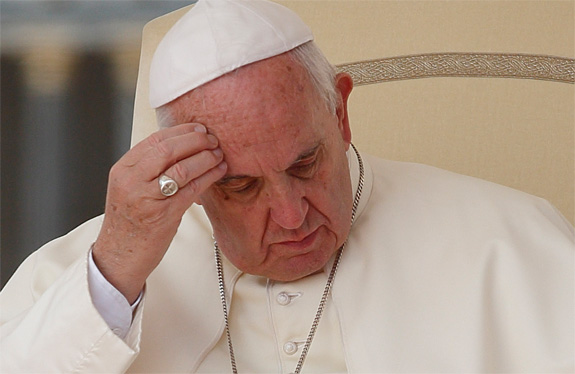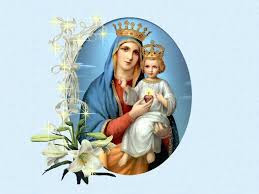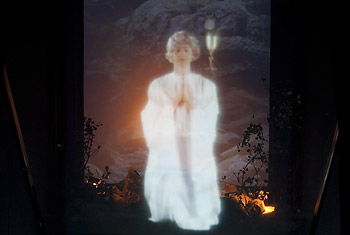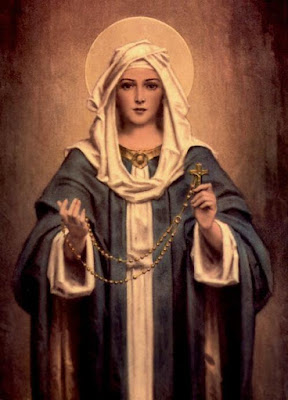Women deacons?
The Pope is once again causing confusion... HERE.*sigh*
I am a Catholic woman proud of the roles I and other women parishioners play in the Church-- so I'm not a "chauvinistic pig"...
We women do have a vital and great role in the Church BUT NOT IN THE DIACONATE OR HOLY ORDERS!!!
For those who think women are second rate citizens in the Church please, look around you. WE ARE NOT!
We follow Our Holy Mother Mary
the Great Mother of God
SHE IS NOT A SECOND RATE CITIZEN!!!
There are many responsibilities that women fill. I know in our parish, it's the women who insure that the Liturgical aspects are taken care of - the decorating for Feast Days, cleaning of the Altar cloths etc. for Mass, Fund raising committees, and much more! Working behind the scenes but still very important to the Church.
Here are some more examples:
~ They have equal rights to be sponsors at Baptism and
Confirmation.
~ Women can serve on the parish council and
finance committees.
~ They can be readers at Mass,
~ They can work in the parish office
~ Teach
Religious Ed, and so on, just like their male counterparts.
~ And many parishes
have women pastoral associates — usually nuns or religious sisters who help the
pastor with many spiritual and pastoral duties.
~ The Church has women who are
canon lawyers, judges, and chancellors across the country.
~ Usually through
religious communities that saw women leading universities, hospitals, and even
Catholic newspapers, long before their secular sisters were able to take
advantage of similar opportunities.
A GREAT EXAMPLE OF WHAT A WOMAN CAN ACCOMPLISH IN THE CATHOLIC CHURCH IS
MOTHER ANGELICA
who herself was called
BY GOD
and answered Him to start
the International Catholic Network EWTN...
that reaches millions of souls around the world!!
She didn't have to be a priest or deacon for that!
My own opinion is that
to push for women deacons and priests
is a sign of PRIDE, which is a MORTAL SIN.
JESUS DID NOT HAVE WOMEN APOSTLES...
I, in all humility, will follow Our Lord Jesus Christ and the Magisterium!! And be a faithful slave and servant to His Holy Mother!!!
Proof From the Vatican website:
IV. The Ministry of Deaconesses
In the apostolic era different forms of diaconal assistance
offered to the Apostles and communities by women seem to have been
institutional. Thus Paul recommends to the community at Rome "our sister
Phoebe, servant [he diakonos] of the Church at Cenchreae" (cf. Rom
16:1-4). Although the masculine form of diakonos is used here, it cannot therefore
be concluded that the word is being used to designate the specific function of
a "deacon"; firstly
because in this context diakonos still signifies
servant in a very general sense, and secondly because the word
"servant" is not given a feminine suffix but preceded by a feminine
article.
What seems clear is that Phoebe exercised a recognised service in the
community of Cenchreae, subordinate to the ministry of the Apostle. Elsewhere
in Paul's writings the authorities of the world are themselves called diakonos
(Rom 13:4), and in Second Corinthians 11:14-15 he refers to diakonoi of the
devil.
Exegetes are divided on the subject of First Timothy 3:11.
The mention of "women" following the reference to deacons may suggest
women deacons (by parallel reference), or the deacons' wives who had been
mentioned earlier. In this epistle, the functions of the deacon are not
described, but only the conditions for admitting them.
It is said that women
must not teach or rule over men
(1 Tim 2:8-15).
But the functions of governance
and teaching were in any case reserved to the bishop (1 Tim 3:5) and to priests
(1 Tim 5:17), and not to deacons.
Widows constituted a recognised group in the
community, from whom they received assistance in exchange for their commitment
to continence and prayer. First Timothy 5:3-16 stresses the conditions under
which they may be inscribed on the list of widows receiving relief from the
community, and says nothing more about any functions they might have.
Later on
they were officially "instituted" but "not ordained";58
they constituted an "order" in the Church,59 and would never have any
other mission apart from good example and prayer.
At the beginning of the second century a letter from Pliny
the Younger, governor of Bithynia, mentioned two women who were described by
the Christians as ministrae, the probable equivalent of the Greek diakonoi (10,
96-97). It was not until the third century that the specific Christian
termsdiaconissa or diacona appeared.
From the end of the third century on-wards, in certain regions
of the Church 60 (and not all of them), a specific ecclesial ministry is
attested to on the part of women called deaconesses.61 This was in Eastern
Syria and Constantinople. Towards 240 there appeared a singular
canonico-liturgical compilation, the Didascalia Apostolorum (DA), which was not
official in character. It attributed to the bishop the features of an
omnipotent biblical patriarch (cf. DA 2, 33-35, 3). He was at the head of a
little community which he governed mainly with the help of deacons and
deaconesses. This was the first time that deaconesses appeared in an
ecclesiastical document.
In a typology borrowed from Ignatius of Antioch, the
bishop held the place of God the Father, the deacon the place of Christ, and
the deaconess that of the Holy Spirit (the word for "Spirit" is
feminine in Semitic languages), while the priests (who are seldom mentioned)
represented the Apostles, and the widows, the altar (DA 2, 26, 4-7). There is
no reference to the ordination of these ministers.
The Didascalia laid stress on the charitable role of the
deacon and the deaconess. The ministry of the diaconate should appear as
"one single soul in two bodies". Its model is the diakonia of Christ,
who washed the feet of his disciples (DA 3, 13, 1-7). However, there was no
strict parallelism between the two branches of the diaconate with regard to the
functions they exercised.
The deacons were chosen by the bishop to
"concern themselves about many necessary things", and the deaconesses
only "for the service of women" (DA 3, 12, 1).
The hope was expressed
that "the number of deacons may be proportionate to that of the assembly
of the people of the Church" (DA 3, 13, l).62 The deacons administered the
property of the community in the bishop's name. Like the bishop, they were
maintained at its expense. Deacons are called the ear and mouth of the bishop
(DA 2, 44, 3-4). Men from among the faithful should go through the deacons to
have access to the bishop, as women should go through the deaconesses (DA 3,
12, 1-4). One deacon supervised the entries into the meeting place, while
another attended the bishop for the Eucharistic offering (DA 2, 57, 6).
Deaconesses should carry out the anointing of women in the
rite of baptism, instruct women neophytes, and visit the women faithful, especially
the sick, in their homes.
They were forbidden to confer baptism themselves, or
to play a part in the Eucharistic offering (DA 3, 12, 1-4).
The deaconesses had
supplanted the widows. The bishop may still institute widows, but they should
not either teach or administer baptism (to women), but only pray (DA 3, 5, 1-3,
6, 2).
The Constitutiones Apostolorum, which appeared in Syria
towards 380, used and interpolated the Didascalia, the Didache and the Traditio
Apostolica. The Constitutiones were to have a lasting influence on the
discipline governing ordinations in the East, even though they were never
considered to be an official canonical collection. The compiler envisaged the
imposition of hands with the epiklesis of the Holy Spirit not only for bishops,
priests and deacons, but also for the deaconesses, sub-deacons and lectors (cf.
CA 8, 16-23).
63The concept of kleros Was broadened to all those who exercised a
liturgical ministry, who were maintained by the Church, and who benefited from
the privileges in civil law allowed by the Empire to clerics, so that the
deaconesses were counted as belonging to the clergy while the widows were
excluded.
Bishop and priests were paralleled with the high priest and the
priests respectively of the Old Covenant, while to the Levites corresponded all
the other ministries and states of life: "deacons, lectors, cantors,
door-keepers, deaconesses, widows, virgins and orphans" (CA 2, 26, 3; CA
8, 1, 21).
The deacon was placed "at the service of the bishop and the
priests" and should not impinge on the functions of the latter.64 The
deacon could proclaim the Gospel and conduct the prayer of the assembly (CA 2,
57, 18), but only the bishop and the priests exhorted (CA 2, 57, 7).
Deaconesses took up their functions through an epithesis cheirôn or imposition
of hands that conferred the Holy Spirit,65 as did the lectors (CA 8, 20, 22).
The bishop pronounced the following prayer: "Eternal God, Father of our
Lord Jesus Christ, creator of man and woman, who filled Myriam, Deborah, Anne
and Hulda with your spirit; who did not deem it unworthy for your Son, the
Only-Begotten, to be born of a woman; who in the tent of witness and in the
temple did institute women as guardians of your sacred doors, look now upon
your servant before you, proposed for the diaconate: grant her the Holy Spirit
and purify her of all defilement of flesh and spirit so that she may acquit
herself worthily of the office which has been entrusted to her, for your glory
and to the praise of your Christ, through whom be glory and adoration to you,
in the Holy Spirit, world without end. Amen."66
The deaconesses were named before the sub-deacon who, in his
turn, received a cheirotonia like the deacon (CA 8, 21), while the virgins and
widows could not be "ordained" (8, 24-25).
The Constitutiones insist
that the deaconesses should have no liturgical function (3, 9, 1-2), but should
devote themselves to their function in the community which was "service to
the women" (CA 3, 16, 1)
and as intermediaries between women and the
bishop. It is still stated that they represent the Holy Spirit, but they
"do nothing without the deacon" (CA 2, 26, 6). They should stand at
the women's entrances in the assemblies (2, 57, 10). Their functions are summed
up as follows:
"The deaconess does not bless, and she does not fulfil any
of the things that priests and deacons do, but she looks after the doors and
attends the priests during the baptism of women, for the sake of decency"
(CA 8, 28, 6).
This is echoed by the almost contemporary observation of
Epiphanius of Salamis in his Panarion, in around 375:
"There is certainly
in the Church the order of deaconesses, but this does not exist to exercise the
functions of a priest, nor are they to have any undertaking committed to them,
but for the decency of the feminine sex at the time of baptism."
67A law
of Theodosius of 21 June 390, revoked on 23 August of the same year, fixed the
age for admission to the ministry of deaconesses at 60. The Council of
Chalcedon (can. 15) reduced the age to 40, forbidding them subsequent
marriage.68
Even in the fourth century the way of life of deaconesses
was very similar to that of nuns. At that time the woman in charge of a
monastic community of women was called a deaconess, as is testified by Gregory
of Nyssa among others.69 Ordained abbesses of the monasteries of women, the
deaconesses wore the maforion, or veil of perfection. Until the sixth century
they still attended women in the baptismal pool and for the anointing. Although
they did not serve at the altar, they could distribute communion to sick women.
When the practice of anointing the whole body at baptism was abandoned,
deaconesses were simply consecrated virgins who had taken the vow of chastity.
They lived either in monasteries or at home. The condition for admission was
virginity or widowhood and their activity consisted of charitable and
health-related assistance to women.
At Constantinople the best-known of the fourth-century
deaconesses was Olympias, the superior of a monastery of women, who was a protegee
of Saint John Chrysostom and had put her property at the service of the Church.
She was "ordained" (cheirotonein) deaconess with three of her
companions by the patriarch. Canon 15 of the Council of Chalcedon (451) seems
to confirm the fact that deaconesses really were "ordained" by the
imposition of hands (cheirotonia). Their ministry was called leitourgia and
after ordination they were not allowed to marry.
In eighth-century Byzantium, the bishop still imposed his
hands on a deaconess, and conferred on her the orarion or stole (both ends of
which were worn at the front, one over the other);
he gave her the chalice,
which she placed on the altar without giving communion to anyone.
Deaconesses
were ordained in the course of the Eucharistic liturgy, in the sanctuary, like
deacons.70 Despite the similarities between the rites of ordination,
deaconesses did not have access to the altar or to any liturgical ministry.
These ordinations were intended mainly for the superiors of monasteries of
women.
It should be pointed out that in the West there is no trace
of any deaconesses for the first five centuries.
The Statuta Ecclesiae antiqua
laid down that the instruction of women catechumens and their preparation for
baptism was to be entrusted to the widows and women religious "chosenad
ministerium baptizandarum mulierum".71
Certain councils of the fourth and
fifth centuries reject every ministerium feminae72 and forbid any ordination of
deaconesses.73 According to the Ambrosiaster (composed at Rome at the end of
the fourth century),
the female diaconate was an adjunct of Montanist
("Cataphrygian") heretics.74
In the sixth century women admitted into
the group of widows were sometimes referred to as deaconesses. To prevent any
confusion the Council of Epaone forbade "the consecrations of widows who
call themselves deaconesses".75 The Second Council of Orleans (533)
decided to exclude from communion women who had "received the blessing for
the diaconate despite the canons forbidding this and who had remarried".76
Abbesses, or the wives of deacons, were also called diaconissae, by analogy
with presbyterissae or even episcopissae.77
The present historical overview shows that a ministry of
deaconesses did indeed exist, and that this developed unevenly in the different
parts of the Church.
It seems clear that this ministry was not perceived as
simply the feminine equivalent of the masculine diaconate.
At the very least it
was an ecclesial function, exercised by women, sometimes mentioned together
with that of sub-deacon in the lists of Church ministries.78 Was this ministry
conferred by an imposition of hands comparable to that by which the episcopate,
the priesthood and the masculine diaconate were conferred? The text of the
Constitutiones Apostolorum would seem to suggest this, but it is practically
the only witness to this, and its proper interpretation is the subject of much
debate.79 Should the imposition of hands on deaconesses be considered the same
as that on deacons, or is it rather on the same level as the imposition of
hands on sub-deacons and lectors? It is difficult to tackle the question on the
basis of historical data alone. In the following chapters some elements will be
clarified, and some questions will remain open. In particular, one chapter will
be devoted to examining more closely how the Church through her theology and
Magisterium has become more conscious of the sacramental reality of Holy Orders
and its three grades. But first it is appropriate to examine the causes which
led to the disappearance of the permanent diaconate in the life of the Church.
[end quote]
Vatican link: http://www.vatican.va/roman_curia/congregations/cfaith/cti_documents/rc_con_cfaith_pro_05072004_diaconate_en.html
'No need for the Pope to tell the world he is going to get a
commission together to look into this already looked into and defined subject.
He is only causing confusion and discord once again!'
Thanks to the Connecticut Catholic Corner for this article!! http://connecticutcatholiccorner.blogspot.ca/


















